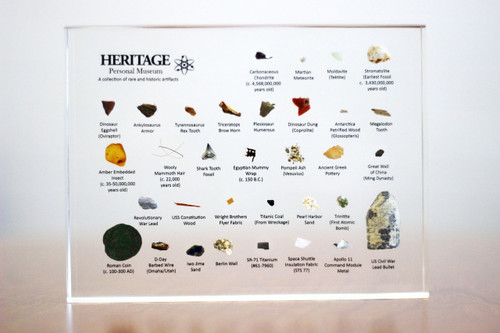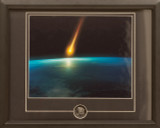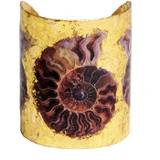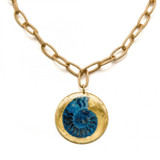- Home
- Curated Collections
- Art & Collectibles Curated Collection
- Heritage Personal Miniature Museum - Wright Flyer, Meteorite, Fossil, Coins, Artifacts
Heritage Personal Miniature Museum - Wright Flyer, Meteorite, Fossil, Coins, Artifacts
Product Description
*** SPECIAL : FREE EXPRESS SHIPPING UPGRADE (2-3 DAY), Just Checkout with Standard Free 3-8 Day Shipping Option and we'll automatically upgrade to EXPRESS 2-3 Day Shipping at No Charge! ***
The Heritage Personal Miniature Museum is a collection of artifacts from the history of the world. The specimens have been specifically selected and curated for the museum. From meteorites and dinosaur fossils to barbed wire from D-Day, the personal museum includes artifacts from some of the most important events in history. Each artifact is broken up into smaller samples and carefully prepared for inclusion. The samples are then professionally cast in acrylic. The museums are polished to a glass-like surface and will last for generations with proper care. Each artifact in the museum is authentic and has inherent historical importance. The artifacts span not only the history of the world but also the history of the universe. Each museum is unique and will vary in appearance. The photos shown above depict a sample museum. Also, please keep in mind that there might be small imperfections with the castings.
- Revolutionary War Lead
- USS Constitution Wood
- Civil War Bullet
- Wright Brothers Flyer Fabric
- SR-71 Titanium
- Space Shuttle Insulation
- Apollo 11 Command Module Metal
- Sand from Pearl Harbor
- D-Day Barbed Wire (Utah/Omaha Beaches)
- Sand from Iwo Jima
- Berlin Wall
- Titanic Coal
- Great Wall of China Fragment
- Ancient Greek Pottery
- Coin from the Roman Empire (c. 300 AD)
- Pompeii Ash
- Egyptian Mummy Linen (c. 100 BCE)
- Woolly Mammoth Hair
- Mini Shark Tooth Fossil
- Megaolodon Tooth
- Petrified Wood from Antarctica
- Insect Embedded in Amber
- Ankylosaurus Armor
- Tyrannosaurus Rex Tooth
- Dinosaur Egg Shell
- Dinosaur Coprolite
- Triceratops Brow Horn
- Plesiosaurus Bone
- Moldavite
- Stromatolite
- Martian Meteorite
- Carbonaceous Chondrite
Revolutionary War Musket Ball

"These are the times that try men's souls." -Thomas Paine
"We hold these truths to be self-evident: That all men are created equal; that they are endowed by their Creator with certain unalienable rights; that among these are life, liberty, and the pursuit of happiness... that whenever any form of government becomes destructive of these ends, it is the right of the people to alter or to abolish it, and to institute new government..." -Thomas Jefferson, Declaration of Independence
The American Revolutionary War was undoubtedly the single most important event in US history. These lead musket balls are from the Battle of White Plains, New York. Each museum will contain a fragment of the musket balls.
USS Constitution Wood

"The Constitution is, in many aspects, the key historical symbol of the American Navy." -Prof. Brendan McConville
The USS Constitution was one of the first ships commissioned to be built for the United States Navy and was named by George Washington himself. The frigate played an important role in the War of 1812, in which it defeated five British warships. The wood included in the museum was obtained from the Museum of Monterey as a deaccessioned artifact.
US Civil War Bullet

"...We here highly resolve that these dead shall not have died in vain, that this nation under God shall have a new birth of freedom, and that government of the people, by the people, for the people shall not perish from the earth." -Abraham Lincoln
The battle that was fought in Gettysburg, Pennsylvania was perhaps the most pivotal event in the American Civil War. From July 1st to July 3rd, 1863, Confederate and Union soldiers fought in what would become one of the bloodiest battles. Though the Civil War continued for another two years, the Battle of Gettysburg turned the tide of the war.
These bullets were collected from various Civil War sites including Gettysburg and Bull Run. Each museum will come with a profiled bullet from this historic war. The bullets will be divided in half through their length before casting.
Wright Brothers Flyer Fabric

"The Wright Brothers created the single greatest cultural force since the invention of writing. The airplane became the first World Wide Web, bringing people, languages, ideas, and values together." -Bill Gates
December 17th, 1903, the Wright brothers made history by achieving the first successful flight of a manned plane. This historic flight was achieved in a scratch-built plane powered by a 4 cylinder, 12 hp engine. Wilbur and Orville Wright's fascination with aeronautics helped them to pioneer aviation.
After a few years and hundreds of more successful flights, the Wright brothers were building planes and training other pilots. The fabric included in the museum came from the "Vin Fiz", the first plane to successfully fly across the United States. The fabric was obtained from the Smithsonian.
SR-71 Titanium

The Heritage Museum shows the progress of engineering from the Wright brothers' flyers to the world's fastest aircraft.
The SR-71 was engineered by Lockheed and the Skunk Works division to be a long-range reconnaissance jet capable of flying at an altitude of 85,000 feet. Because of it's tremendous speed (Mach 3.2+ or 2,464 MPH), not a single SR-71 was shot down during service. This high speed also required that the aircraft be constructed with a special titanium alloy.
The sample included in the museum comes from the SR-71 #61-7960.
Apollo 11 Command Module Metal

"Houston, Tranquility Base here. The Eagle has landed." -Neil Armstrong
On July 20, 1969, the world held it's breath as Neil Armstrong and Buzz Aldrin became the first two men to land on the moon. The astronauts were on the lunar surface for a total of 21 hours and 36 minutes. This historic moment exemplified mankind's ability to push the limits of science and engineering. The Heritage Museum contains a sample of metal used in the construction of the lunar module.
The astronauts left a plaque on the surface of the moon that read, “Here men from the planet Earth first set foot on the moon–July 1969 A.D–We came in peace for all mankind.”
Pearl Harbor Sand

“If everyone fought for their own convictions there would be no war.” -Leo Tolstoy
The Japanese military strike on the US naval base at Pearl Harbor occurred on the morning of December 7th, 1941. By the end of the day, 188 aircraft were destroyed and 8 battleships were damaged with 4 being sunk. This surprise attack on Pearl Harbor was the driving force behind the United States' entry into World War II. This sand was collected from a beach in Pearl Harbor, but not from the protected historical site.
D-Day Barbed Wire

"Never in the field of human conflict was so much owed by so many to so few." -Winston Churchill
On June 6, 1944, approximately 156,000 Allied troops landed along a 50 mile stretch of heavily-fortified coastline, to fight against Nazi Germany on the beaches of Normandy. Barbed wire was seen throughout the coastlines. The wire included in the museum stands as a memorial to those who fought in the defense of freedom and represents the struggles and obstacles they overcame.
Iwo Jima Sand

"Among the men who fought on Iwo Jima, uncommon valor was a common virtue" -Admiral Nimitz
On February 19th, 1945, US Marines landed on the island of Iwo Jima, initiating one of the fiercest invasions of World War II. The sand included in the museum was collected by a Marine veteran who visited the island in 2007.
Berlin Wall

“Many small people, who in many small places do many small things, can alter the face of the world.” - Berlin Wall Marking
The barrier which divided East Berlin from West Berlin was a tangible portrayal of the struggle between communism and democracy. The samples of the Berlin Wall were obtained by members of the Heritage Museum team.
“There are many people in the world who really don’t understand, or say they don’t, what is the great issue between the free world and the Communist world. Let them come to Berlin. There are some who say that communism is the wave of the future. Let them come to Berlin... And there are even a few who say that it is true that communism is an evil system, but it permits us to make economic progress. Lass’ sie nach Berlin kommen. Let them come to Berlin.” ~ John F. Kennedy
Titanic Coal

"There is no danger that Titanic will sink. The boat is unsinkable and nothing but inconvenience will be suffered by the passengers." -Phillip Franklin
The famous R.M.S. Titanic was an enormous ship for it's time. The steam-powered vessel had 29 boilers which required hundreds of tons of coal every day. Though the Titanic sank on April 15th, 1912, it wasn't until 1985 that the ship was discovered. The wreckage was located 13 miles away from the final coordinates given during the distress signal.
The Titanic coal included in the Heritage Museum was recovered during the "Titanic Research and Recovery Expedition" of 1994.
Great Wall of China (c. ~1500 AD)

"Do the difficult things while they are easy and do the great things while they are small. A journey of a thousand miles must begin with a single step." -Lao Tzu
As the world's longest wall ever constructed (13,171 miles / 21,196 km!), the Great Wall of China has earned its place as one of the New 7 World Wonders. The idea of a defensive wall was originally devised by Emperor Qin Shi Huang (c. 259-210 B.C.). However, construction of the wall spanned several centuries.
The fragment of the Great Wall of China in the museum collection was obtained by governmental permission from the Badaling Section.
Ancient Greek Pottery

Our knowledge of the culture of Ancient Greece is due in large measure to the durability of ancient pottery.
Although the style continually changed over time, pottery was an integral part of ancient Greece. The Greeks used pottery for a wide range of things including food storage, decoration, and even tomb marking. Greek potters were incredibly skilled at their trade and pottery was traded throughout the Mediterranean. The sample of pottery in the Heritage Museum dates to the 4th century B.C.
Roman Empire Coin (c. ~300 AD)

"Rome has grown since its humble beginnings that it is now overwhelmed by its own greatness." -Titus Livius
At its height, the Roman Empire extended from Europe and Northern Africa to Western Asia and ruled over one fifth of the world's population. Innovations in construction, aqueducts, roads, and plumbing were all legacies left by the Romans. Coins were first minted in the Roman Empire in the 4th century B.C. The ancient coin included in the Heritage Museum comes from this profoundly influential empire.
Pompeii Ash

"Our duty is to hold on to the lost position... without rescue, like that Roman soldier whose bones were found in front of a door in Pompeii, who, during the eruption of Vesuvius, died at his post because they forgot to relieve him." -Oswald Spengler
In 79 AD, Mt. Vesuvius erupted, covering the beautiful city of Pompeii. This ancient Roman city was buried in several meters of ash. Although much of the city was destroyed, some portions - as well as the people - were preserved in the volcano's ash. The structures, bodies, and artifacts of this historic city remained untouched until 1748 when excavation began. The preserved specimens give us a glimpse of life in the Roman Empire. The sample of ash was obtained by a geologist in 1982.
Egyptian Mummy Linen (c. 100 BCE)

Two hundred and fifty mummies covered in gold. Something like this cannot be explained - mummy after mummy covered in shining gold." -Zahi Hawass
Mummification in ancient Egypt was an elaborate process that required special tools, bitumen, and hundreds of yards of linen. This religious ritual was performed by priests and took around 70 days. The preservation of such mummies over thousands of years is remarkable.
Mammoth Hair

Mammoths had exceptionally thick, coarse hair which provided insulation in extreme climates. With tusks up to 15 feet long and a body mass of 6 tons, the Woolly Mammoth was nothing short of a behemoth. Being covered in heavy fur, Mammoths were well prepared to survive the ice-age. This fur consisted of a longer "guard hair" as well as a short undercoat. The museum sample of Mammoth hair is a combination of the guard hair and undercoat and exhibits a defined contrast of colors.
Mini Shark Tooth Fossil

Sharks have inhabited the oceans for approximately 450 million years, making them older than the dinosaurs. These miniature teeth are the only remains of sharks that lived hundreds of thousands and even millions of years ago. Incredibly, sharks have survived four of the five major extinction events in the history of the earth. The teeth come from a wide variety of species and range from 1/8" to 3/8" long.
Antarctica Petrified Wood

"The vegetation in Antarctica in the Eocene period, 50 million years ago, was very similar to that in Chile today - suggesting strong evolutionary connections between Antarctica and South America." -Claire McDonald
It is difficult to imagine Antarctica with thick forests, but millions of years ago, that is exactly what it looked like. The museum includes a specimen of petrified Fern wood (Glossopteris) which was found on a scientific expedition to the icy continent in the 1960's. Glossopteridales first appeared in Antarctica in the early Permian period (~298.9 million years ago).
Insect Embedded in Amber

"...Some catastrophe, probably a tropical storm, destroyed the forest (causing) massive amounts of resin to bleed.” -Dr. David Grimaldi
Amber is formed when tree resin becomes fossilized. While the sap is fresh, insects will sometimes become trapped in it. The insects which were entrapped in these pieces of amber lived millions of years ago. Each museum will include an insect encapsulated in amber.
Moldavite (Tektite)

Franz Suess, a geology professor in Vienna, was the first to recognize the cosmic origin of Moldavite. Moldavite is a semi-precious mineral with cosmic origin. This translucent green tektite formed as a result of a meteorite impact roughly 14,700,000 years ago. It is found in the Czech Republic and is becoming increasingly scarce.
Ankylosaurus Armor

Ankylosaurus was heavily armored with plates of bone embedded in its skin. The Ankylosaurus was a heavily armored herbivore which existed 66-75,000,000 years ago. The characteristic armor, spines, and tail club of the Ankylosaur acted as a stout defense against predators.The tail club of the Ankylosaur is thought to have had enough force to break the bones of attackers. The closest known relative of the Ankylosaur is the Stegosaurus.
Triceratops Brow Horn

The horns of the Triceratops actually changed shape throughout its life, eventually curving forward and growing up to 3 feet in length. Triceratops is one of the most fascinating dinosaurs to ever walk the planet and happens to be our personal favorite. The name comes from Greek, literally translating to "Three Horned Face". This giant herbivore roamed North America 65-67 million years ago and could grow to be well over 11,000 lbs (5,000 kg). Each museum will include a fragment of a Triceratops brow horn.
Tyrannosaurus Rex Tooth

Tyrannosaurus Rex - The name itself means 'king of the tyrant lizards'. A 4 foot jaw, large serrated teeth, and a body length of 40 feet all made the Tyrannosaurus rex one of the most ferocious and powerful theropods to ever exist. Scientists believe that the T-rex could consume 500 pounds of meat and bone in one bite. Now you can own a piece of this incredible dinosaur!
Dinosaur Egg Shell
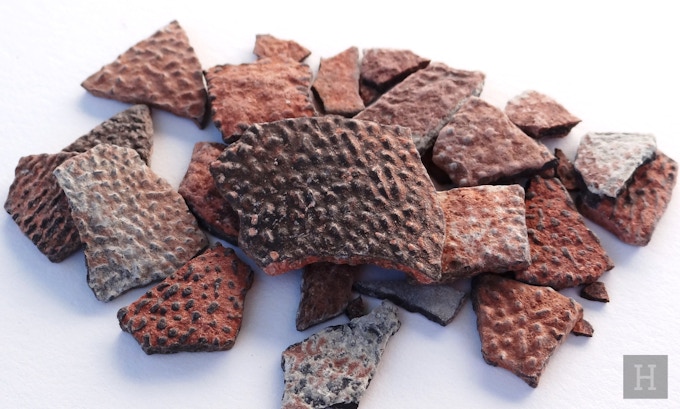
On a rare occasion, the embryo within a dinosaur egg is fossilized along with the shell.
These egg shell fragments are from the Oviraptor, a small Theropod dinosaur. This sample of egg shell was selected for the museum due to the unique color and texture.
Dinosaur Coprolite

Sauropod dinosaurs, weighing upwards of 80 tons, had to eat several hundred pounds of plants and leaves every day in order to sustain themselves. As such, there was undoubtedly a tremendous amount of dinosaur dung throughout the Mesozoic era. The Heritage Museum specimen is an end-slice from a larger piece of fossilized dinosaur dung.
Stromatolite (Oldest Known Fossil)

"They were one of the earliest examples of the intimate connection between biology - living things - and geology - the structure of the Earth itself." -Joan Bernhard
Dating to approximately 3,430,000,000 years old, stromatolites from the Strelley Pool formation in Australia are the earliest known fossils. At that time, most forms of life on earth were single-cell organisms. It's difficult to fathom just how old these fossils truly are.
Martian Meteorite

"I Would Like to Die on Mars. Just Not on Impact." -Elon Musk
Martian meteorites are among some of the most rare extraterrestrial rocks to fall to the earth. These meteorites undergo heavy scrutiny in order to determine whether they are in fact from Mars. Scientists analyze martian meteorites to broaden our understanding of the Red Planet and its history. Suffice it to say that it is fascinating to be able to hold a piece of Mars in the palm of your hand.
Carbonaceous Chondrite

These meteorites contain matter from a supernova that predates the Solar System itself. Carbonaceous Chondrites are an exceptionally rare class of meteorites that give us a glimpse into the creation of the Solar System. These meteorites date back to approximately 4,568,200,000 years ago, making them the most primitive matter on earth.
 Loading... Please wait...
Loading... Please wait...

